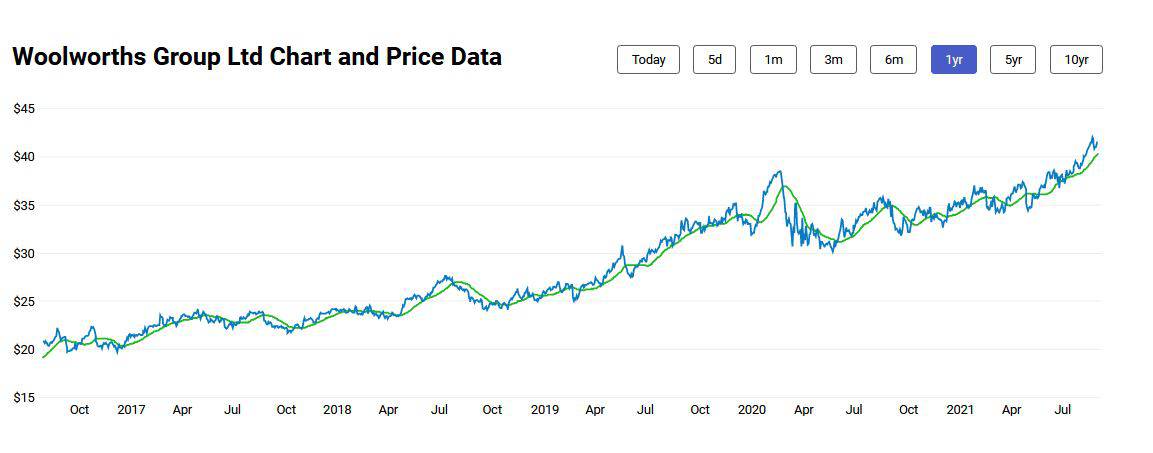The Woolworths Group Ltd (ASX: WOW) share price has long been a stable presence on the ASX share market. Since its listing on the ASX boards back in 1993, Woolworths shares have been traded and owned for decades.
But what can we learn from the recent Woolworths share price history? What have been its biggest ups and downs over the past 5 years?
That's what we'll be looking to today.
So, to kick things off, here is a share price graph of the Woolworths share price over the past 5 years:

It's clearly been a pretty smooth run for investors in Woolworths over the past 5 years. Back at the end of August 2016, this company was asking a share price of roughly $21.80 a share. Today, at the time of writing, the Woolworths share price is sitting at $41.56. up 0.29% for the day so far.
That means that over the past 5 years, Woolworths shares have delivered a capital return of approximately 90.6%. That compares very favourably against the S&P/ASX 200 Index (ASX: XJO) which has returned around 40% over the same period.
But what have been the company's biggest ups and downs over this period?
Some ups and downs for the Woolworths share price
Well, to start things off, it's important to remember that in late August of 2016, Woolworths shares had just reached the bottom of what we can now call a 2-year slump.
In August 2014, Woolies was going for around $30 a share. Yet, by July 2016, the company was under $18 a share. Looking back, we can blame this slump on the resurgence of Woolies' arch-rival Coles Group Ltd (ASX: COL) which was beginning to fire under the management of its old parent company Wesfarmers Ltd (ASX: WES).
But it was also the time of Woolworths' disastrous foray into the world of hardware. Remember Masters? Woolworths' doomed attempt to compete with Wesfarmers' uber-successful hardware chain Bunnings?
Well, this was around the time Woolworths was hemorrhaging cash from its expansion plans. The company ended up pulling the plug on the whole thing in December 2016, at an enormous cost to shareholders. We can see this being built into Woolies shares between 2014 and 2016. Indeed, it was only in the August of 2019 that Woolworths shares would eventually rise back to the level they were in 2014.
Kaufland exits, and COVID enters
In 2019 and early 2020, we saw the Woolworths share price explode. 2019 saw the company add around 25% to its value, while the period between 1 January 2020 and 14 February 2020 saw another near-20% put on top.
At the time, we all thought that the German supermarket giant Kaufland would be entering the Australian retail space, given the company had publically announced expansion plans. But when Kaufland announced that it would be pulling the plug on its Australian plans in January 2020, the Woolworths share price rocketed.
It was only brought back to Earth by the subsequent outbreak of the coronavirus pandemic a month later. For the first year or so of life with COVID, Woolworths shares largely trod water.
Woolies was more or less left out of the COVID-induced share market crash of early 2020 – largely thanks to the well-publicised panic buying of essential groceries that we saw last year.
How does the Woolworths share price look today?
But in the past 3 months or so, investors have broken the mould and sent Woolworths shares to new heights. After a robust FY21 earnings report, the successful demerger of Endeavour Group Ltd (ASX: EDV) and a new share buyback program, things have never been better for Woolworths share price. Today, it sits pretty close to its post-spin off all-time high as we speak.
Who knows what the future will hold for Woolworths going forward. But we do know that there is still an army of shareholders who will be paying attention!
At the current Woolworths share price, the company has a market capitalisation of $52.53 billion. a price-to-earnings (P/E) ratio of 34 and a dividend yield of 2.61%.









